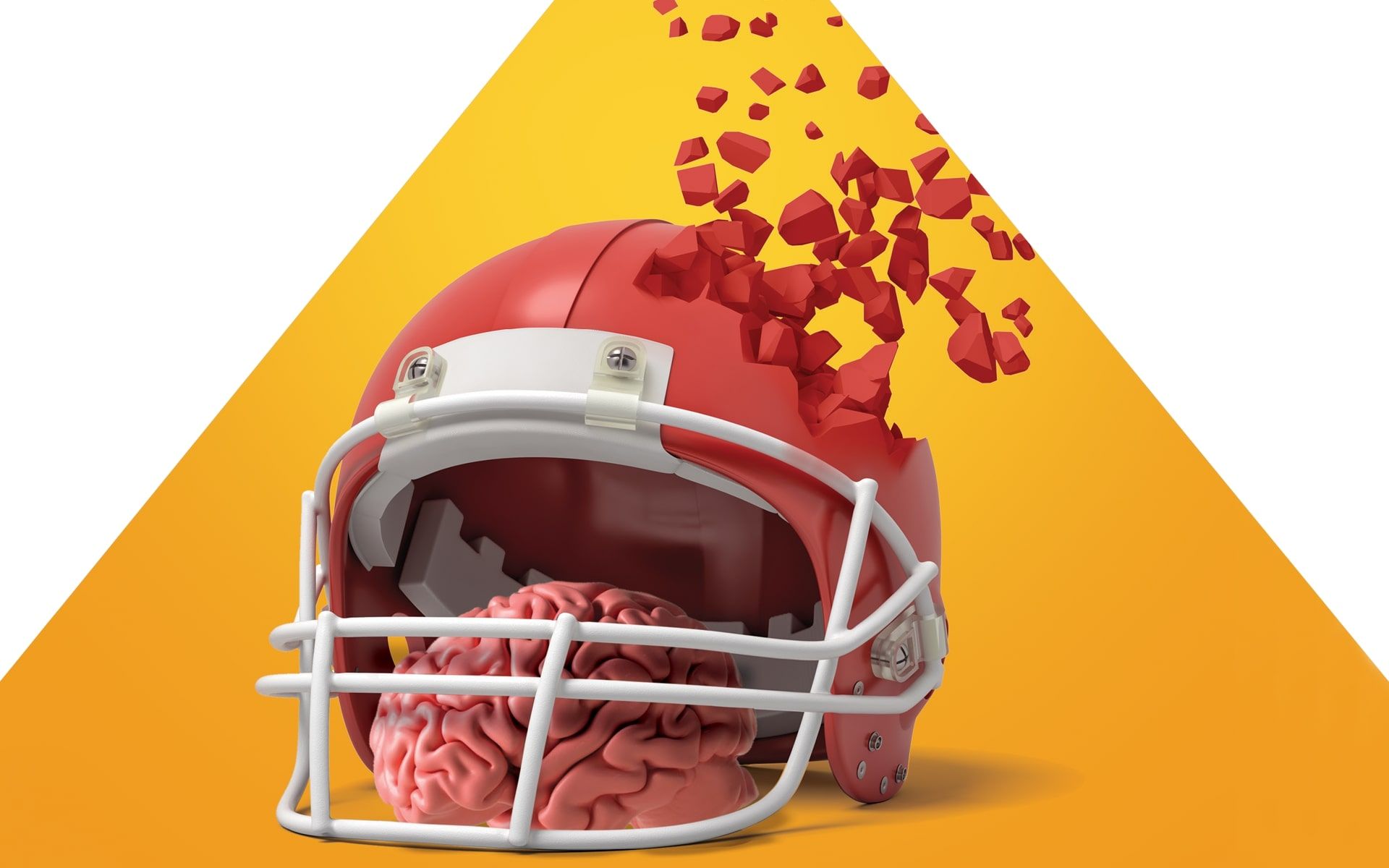Safety Systems Unique to the Brain

In This Article
-
The deaths of some American football players are caused by depression-induced suicide, substance abuse, heart attack, and accidents due to damage to brain tissues.
-
Human skull is made up of 22 different bones, including the eight bones that surround our brain.
-
Unlike other bones, the bones in our skull are fused to each other in an indented or zigzagging pattern. In this way, they perfectly fit into each other in a mutually supportive manner.
Bennet Omalu[1] is a physician specialized as a forensic expert and pathologist, which means he examines the tissues and organs of dead people to determine their cause of death. One day, he was asked to prepare an autopsy report about the corpse of a 50-year-old man named Mike Webster, a former professional US football player[2]. Having examined the corpse in detail, the physician reported his cause of death to be "heart attack." While examining the brain structure during the autopsy, he noticed a pathology normally seen in the brains of boxers, and decided to study this player's life. Mike Webster had been an American football player since his childhood and had been a professional player for 18 years. Dr. Omalu watched this player's games and noticed that Webster often played in the most dangerous positions where collisions with rival players were the highest, and he had sustained very serious blows to his head. Taking into consideration the number of the games he participated in, Omalu calculated that this player had sustained more than 70,000 blows to his head. Realizing that Webster suffered from short-term blackouts after collisions as well, Omalu concentrated his studies on his brain.
Dr. Omalu found out that these shocks triggered a neurological reaction, which in turn led to chronic traumatic encephalopathy (CTE)[3]. He was the first scientist who demonstrated that American football players face the risk of developing this disease.
Having autopsied other people who played American football, Dr. Omalu identified deaths due to brain damage. These deaths were caused by depression-induced suicide, substance abuse, heart attack, and accidents due to damage to brain tissues. He published his findings, despite obstruction and threats from the executives of the National Football League (NFL), a billion-dollar business, as well as other people who profited from this business. Following this publication, new safety measures, such as designing new football helmets and wearing neck protectors, were taken to minimize the damage to players from collisions.
Skull and brain
Our skulls are created in the form of a special cage that protects our brains with a robust bone structure and ovoid shape formed by flat bones. Impacts in sports like American football, wrestling, boxing, ice hockey, or in various accidents will cause no problems up to a certain level. However, collisions bigger than 60G on head may result in concussions and even death. In American football, players may suffer from concussions of the brain as big as 100G upon head-to-head collision even if they wear helmets as this impact is equal to that of getting hit by a sledgehammer.
Akin to a suit of armor made up of bones, our skull protects our brain. It may appear like one simple, unified structure, but our skull is made up of 22 different bones, including the eight bones that surround our brain (excluding those of inner ear)[4]. Unlike other bones, the bones in our skull are fused to each other in an indented or zigzagging pattern. In this way, they perfectly fit into each other in a mutually supportive manner.
Adults have solid and robust skulls while babies have more flexible skulls. As babies grow, their skulls grow proportionally. If the skull grew more slowly, it would have exerted pressure on the brain; in contrast if it grew too quickly there would have been greater space between the skull and the brain and thus would have left the brain more subject to impacts. Moreover, in babies the eight main bones that surround the brain have not fused completely into each other. There are soft gaps between cranial bones called "fontanelle." This is a vital characteristic for babies during birth. If the skull of a baby had been rigid and without these gaps, their skull would be very likely to be crushed during birth. These gaps provide room for flexibility. As babies grow, their skulls grow as well and become rigid as these gaps are filled. The fontanelle also plays a role in the balance mechanisms of babies and it takes some 18 months to become rigid.
Nature
Such protective mechanisms can be observed in nature, too. For instance, gannets are great divers, and they can dive from a height of 30 m with an approximate speed of 100 km/h. Although they dive with such a speed, they sustain no damage. These birds are equipped with "air bags" on their faces and under their skins, which can dampen the impact from the water. Woodpeckers as well as horned animals like rams and deer, which use their heads in hunting or defying their enemies, have skulls created specifically for these purposes.
Woodpeckers, the master carpenters
Woodpeckers uses their bills like a drill and can dig holes in tree trunks to build their nests or hunt for food. They generally feed on woodworms, ants, termites, caterpillars, bugs and larvae. Some woodpecker species use these holes as a storeroom and store certain foods, such as acorns, for the winter. Woodpeckers are picky about the trees in which they will build their nests[5]. They choose dead or very old trees, because these trees have thick bark. They prefer pines, spruce, and certain fruit trees. Scientists note that these birds have an excellent sense of hearing and they can hear the sounds of worms and bugs beneath the barks of trees and select the trees with these worms[6]. A woodpecker can peck a tree trunk at a rate of 15-20 times a second and with a speed of 40-100 km/h. A special locking system protects its bill from the impact. With this system, it can withstand a force of 1,000 G.
Sang-Hee Yoon and Sungmin Park from the University of California demonstrated that these birds' system for dampening impact shock have four main components[7]. These are their hard but elastic beak; spring-like hyoid bone that stretches up to the rear of the skull; the spongy portion in its skull; and the interaction of the spinal fluid with the skull. This magnificent mechanism that absorbs the impact in woodpeckers are similar to dampers used in cars but are more effective because they can absorb shocks in rapid intervals. Woodpeckers have very strong muscles in their necks, and their cranial bones are completely fused. Like a safety belt, their tongues go around their heads and stretch up to their noses.
This perfect system for absorbing shock has inspired scientists to design the black box protection system used in aircrafts[8]. Thanks to this protection mechanism, black boxes are now capable of withstanding impacts of up to 60,000 G.
Scientists from the University of Bath in the United Kingdom have developed a special tool with inspiration from woodpeckers[9]. This specially designed electrical hammer moves back and forth rapidly to perform a hammering motion by utilizing less energy than would be expected. In this way, nails can be driven in a short time. Hammer drills that help us break through hard surfaces have been developed with a similar inspiration.
As we learn more about the amazing creatures that inhibit our world with us we are astonished to realize how magnificently created they each are so they can survive, seek out their sustenance, and fight against their enemies.
Notes
- wikipedia.org/wiki/Bennet_Omalu
- wikipedia.org/wiki/Mike_Webster
- ncbi.nlm.nih.gov/pmc/articles/PMC2945234
- Dr. Arif Sarsılmaz, “Ben Hasan’in Iskeletiyim” (I am Hasan's Skeleton), Sızıntı, January 2001.
- com/why-are-woodpeckers-making-holes-in-my-trees
- ncbi.nlm.nih.gov/pmc/articles/PMC3548892
- newscientist.com/article/dn20088-woodpeckers-head-inspires-shock-absorbers
- popsci.com/technology/article/2011-02/woodpecker-heads-inspire-new-cushioning-systems-electronics-and-humans/
- researchgate.net/profile/Julian_Vincent/publication/245387767_A_woodpecker_hammer/links/0a85e53cd2be397e97000000/A-woodpecker-hammer.pdf









